What can I say, my lunch at The Fat Duck was by far the most spectacular, and expensive, dining experience I’ve ever had – I still get excited just thinking and talking about it, and cannot wait to go back the next time I go to the UK. The Fat Duck is the restaurant that brought fame and fortune to arguably one of the most famous and talented chefs of the modern age – Heston Blumenthal.
Heston has a somewhat unconventional biography as far as Michelin starred chefs go. He is almost entirely self-taught and places a lot of emphasis on really understanding food and cooking in a scientific sense, which has formed the basis of his many collaborations with scientific departments of universities. His cooking philosophy can be succinctly described in two points:
- Question everything
- Food is a multi-sensory experience
The first point should resonate strongly with anybody with a scientific background. Questioning things leads to scientific progress, or in Heston’s case, it leads to new and revised cooking techniques that may break age old traditions that really have no scientific basis. A well-known example is the idea of “sealing” in the juices of a piece of meat by searing the meat in a hot pan, an idea that Harold McGee (author of On Food and Cooking) has shown to be incorrect, which is what inspired Heston to start questioning things. The second point is something that Heston speaks about in many of his TV programs (including his many guest appearances on Masterchef Australia) and speaks for itself at The Fat Duck. Of course food should taste good, but Heston’s philosophy has that our experience is also influenced by how the food looks, what we can smell while eating, what we can hear, and how the food feels to the touch.
I went to the three Michelin starred restaurant with extremely high expectations, given the astronomical prices of the tasting menu (the only option, for 195£ not including drinks or the service charge) and Heston’s notoriety as a chef that understands food and uses it in very unique ways. The restaurant takes bookings online two months in advance, but the 42 seats disappear almost instantly. It took me three successive days to finally get a reservation, so please make sure that you plan this one way in advance, and make sure you are familiar with the booking system before going live*.
We arrived at The Fat Duck after an hour-long train ride from London followed by a ten minute taxi ride. I expected it just because I had previously seen photos, but the exterior of The Fat Duck, previously a pub, was extremely understated and resemblant of a 16th century cottage.
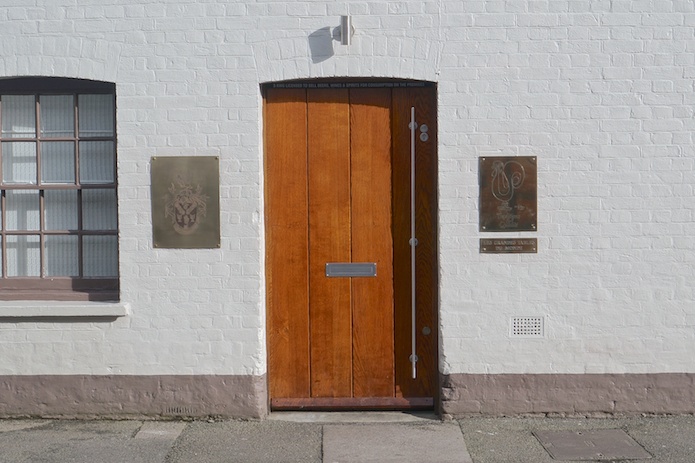
The door to Heston’s magical feast
Our jackets were taken and we were shown to our seats at a table by the window. As is to be expected at a restaurant like this, the service was very refined from the start – the waitstaff appear on cue, they greet everybody in the kindest way possible, and prioritise making guests feel comfortable. In my opinion, one thing that separates good service from great service is an element of unnecessary pretentiousness. Some restaurants can just feel awkward when the waiters put guests on a figurative pedestal higher than themselves and act as if they were born to serve the superior being. Others, The Fat Duck included, maintain an extremely refined wait service, yet do away with the rules that seem to prevent staff from smiling and making the occasional joke. A couple of waiters were interested in the fact that we had come all the way from Australia, and so we engaged in some pre-lunch smalltalk to break the pretentiousness ice.
We were then shown the quite impressive wine list, along with directions on how to navigate it. Don’t expect to find a cheap drop anywhere in the list, and expect to pay around 20£ for even the cheapest glass of wine. For those with a bottomless wallet or bank account, the wine list has some very impressive and very expensive options.

The table setting. Simple and ordinary, yet the meal to come was anything but.
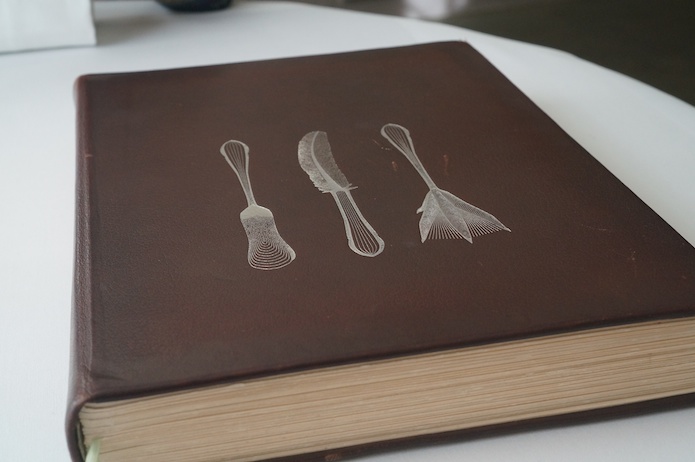
The wine list offered at The Fat Duck. Expect to pay at least 20£ for a glass of wine.
After much excitement of just being there at Heston’s pride and joy, his flagship restaurant, the first appetiser finally came out – aerated beetroot biscuit with horseradish cream. It literally dissolved in the mouth in seconds, leaving behind an intense beetroot flavour.
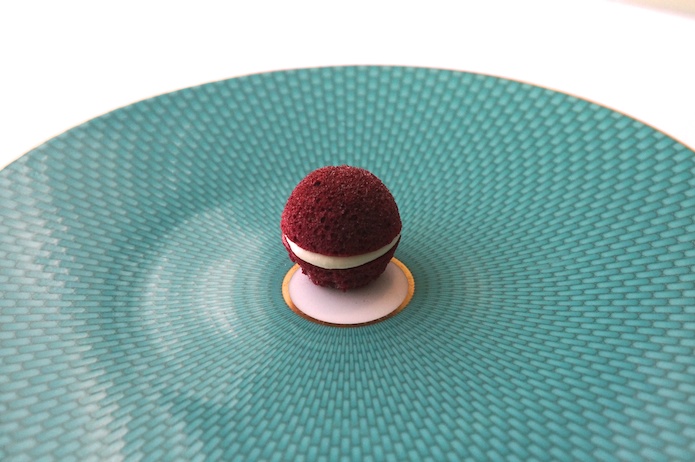
Light as a cloud aerated beetroot biscuits with a horseradish cream.
A few things come to mind when Heston’s name is dropped, one of which is liquid nitrogen. The icy vapours emanating from a pool of super cold liquid nitrogen (-196 degrees Celsius) is surely a symbol of the stereotypical mad scientist, or perhaps just Heston making his famous liquid nitrogen ice cream. Although we weren’t served ice cream, we were served an aperitif with a slightly unconventional twist…a very cold twist. Pushing a trolley with a container of liquid nitrogen and three canisters came a waiter offering a selection of three drinks: Vodka and lime sour, Campari soda, and Tequila with grapefruit. He then created a mousse flavoured with our drink of choice and then froze it instantly in the nitrogen. What resulted was a hard and cold meringue-looking thing that dissolved in an instant when eaten.
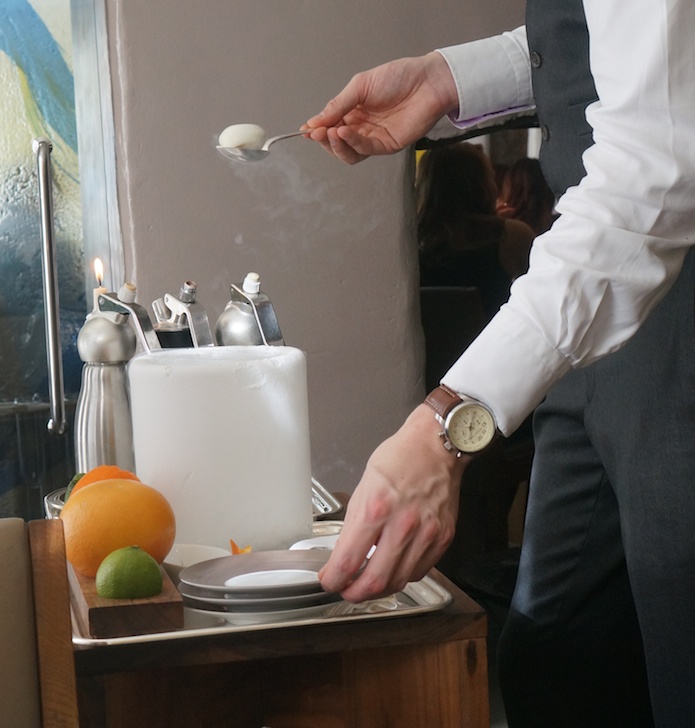
The waiter preparing our nitro-poached aperitif
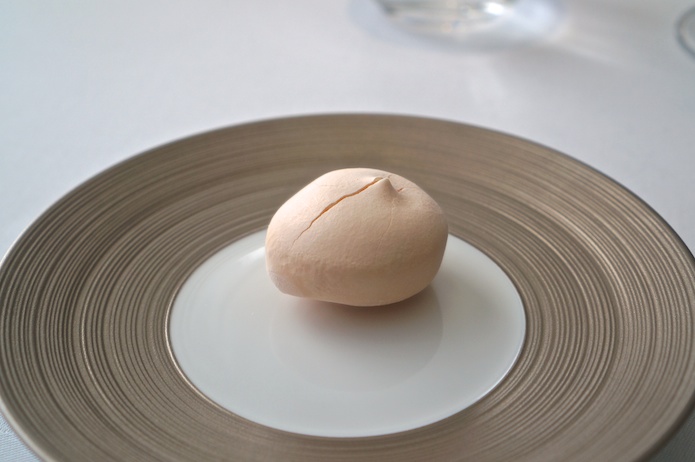
Campari and soda nitro-poached aperitif
The next dish did have an ice cream, however it was not prepared in front of us. This mustard ice cream was served in a bowl, into which a red cabbage gazpacho was poured at the table. The flavours were intense and the textures just perfect. The best part was that the red cabbage gazpacho actually tasted like red cabbage; it was not obscured by other flavours. The same goes for the mustard ice cream.
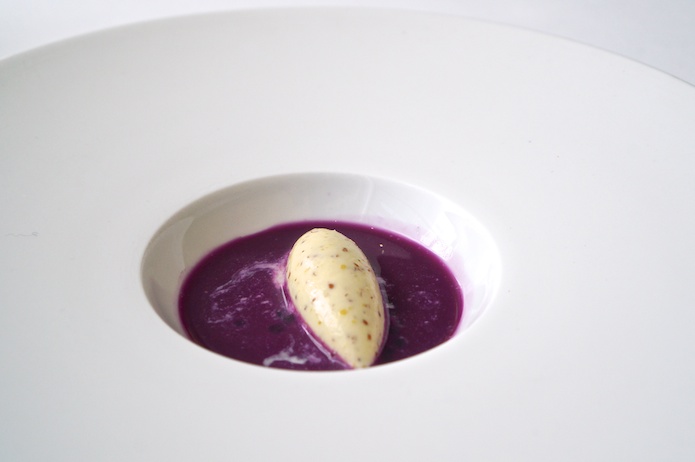
Pommery grain mustard ice cream with red cabbage gazpacho
The next course was a little more complex than the previous, featuring four major components. I mentioned that Heston is all about the multi-sensory experience, and this next course demonstrated that perfectly. We were first given a container labelled “Fat Duck Films”, with a very thin strip of edible paper flavoured with oak and moss. We were instructed to place it on our tongues, after which it dissolved, and experience the flavours of an oak forest. This got our palettes ready. Following this the waiter placed onto the table a box containing some type of moss, into which he poured some liquid nitrogen. The vapours made their way across the table, bringing with them the scents of a forest. This was to heighten and prepare our olfactory senses.
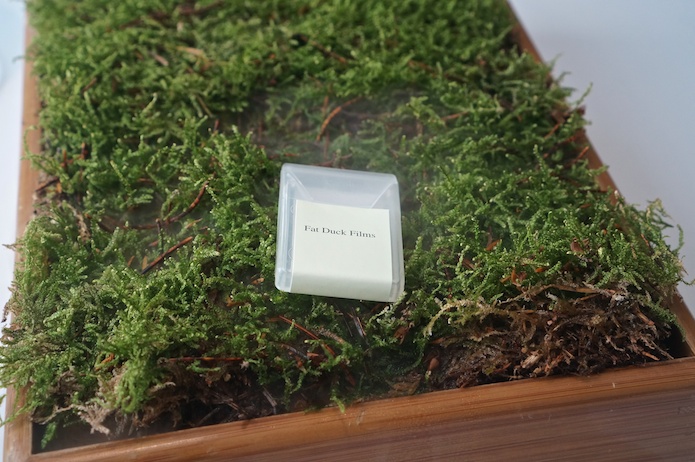
Oak and moss film
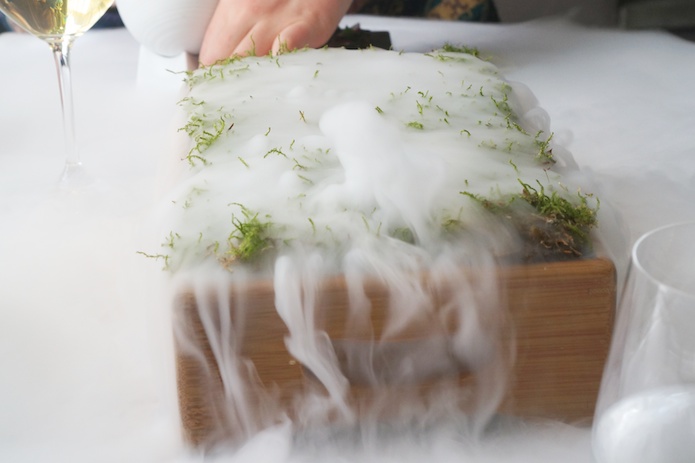
Producing the smell of an oak forest with liquid nitrogen and moss
After the theatre we could finally eat. We were each served two dishes – one containing a tiered trifle (quail jelly, crayfish cream and pea puree), and the other with a piece of truffle toast. I really can’t describe it – it was all just perfect and nothing like I had eaten before.
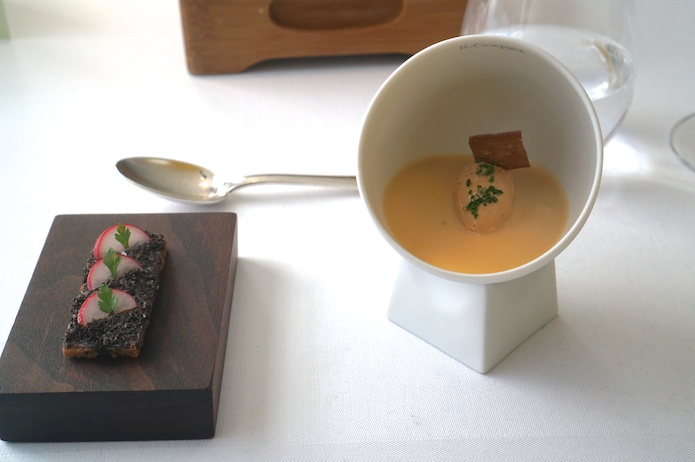
Truffle toast. Jelly of quail, Crayfish cream, and a pea puree.
Heston has a few signature dishes that remain on the menu, and perhaps the most well known is Snail Porridge. Just the name of the dish would send many people running as it conjures up thoughts of slimy grubs swimming in a grey pool of gloop, but of course in reality the dish is not even close to that. What came to the table was a parsley flavoured porridge with an intense green flavour, complemented by shaved fennel, Iberico bellota jamón and, of course, the braised snails.
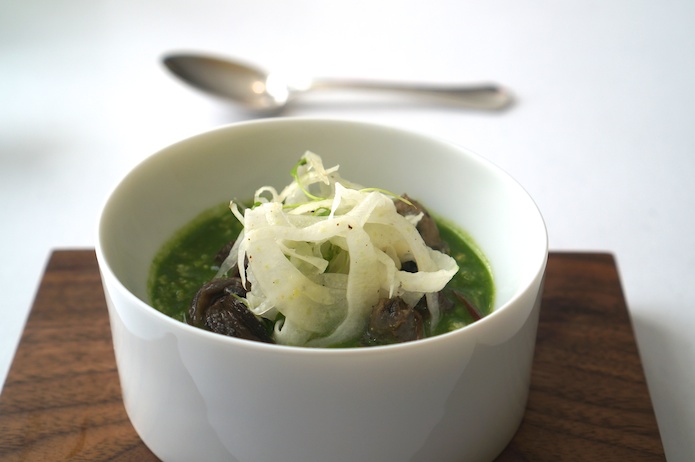
Snail Porridge
I had eaten snails just once before, in Paris, and have learned that they are absolutely not something to squirm about. They can be so delicious if cooked properly and served with the appropriate condiments. They don’t have an overwhelmingly strong flavour, but can bring a delicate earthiness and heartiness to a dish. Together with the cooked oats and fennel, this dish was seriously awe inspiring. I actually can’t believe how good it was – it is not just a famous dish because it belongs to Heston and is a bit quirky, it is famous because it is a genius and genuinely delicious dish, and unlike any I had ever tried. I later found a video of Heston making his famous porridge, and it looks surprisingly simple to make.
The next dish was another 10/10 for me – Roast foie gras with rhubarb gel, confit kombu and a crab biscuit. At this stage I was really impressed by the consistency of the dishes – one perfect, and interesting, dish after another – something that is very difficult to do. Of course the notion of a perfect dish is very subjective, but I truly was astounded each time something new came out.
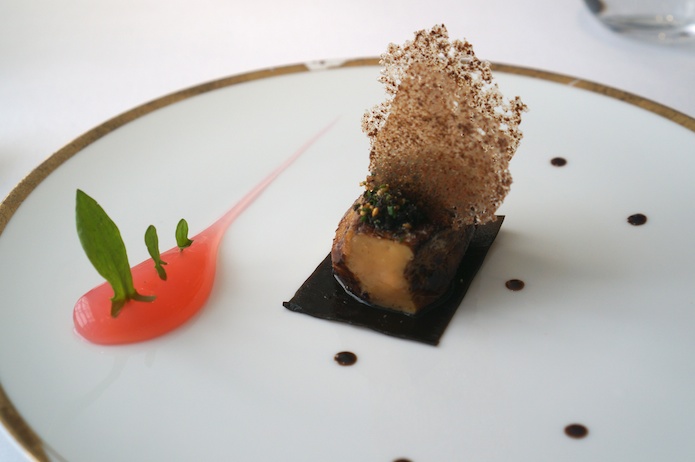
Roast foie gras with rhubarb, confit kombu and crab biscuit
“Have you seen the Mock Turtle yet?”
“No,” said Alice. “I don’t even know what a mock turtle is.”
“It’s the thing Mock Turtle Soup is made from,” said the Queen.
If anybody has seen the Victorian episode of the TV series Heston’s Feasts, they will be all too familiar with the mock turtle soup. In this episode, Heston tries to replicate the concept of mock turtle soup, a dish that is supposed to resemble actual turtle soup that was once eaten in Britain but then became prohibitively difficult to produce due to restrictions on obtaining turtle meat. It is the basis for the Mock Turtle character in Alice’s Adventures in Wonderland, which has the body of a turtle but the head, feet and tail of a calf, an animal often used to produce the mock soup. To my excitement, this was on the menu for lunch.
The course titled Mad Hatter’s Tea Party started with the waiter placing down a glass teapot containing water, egg, mushrooms and ham.
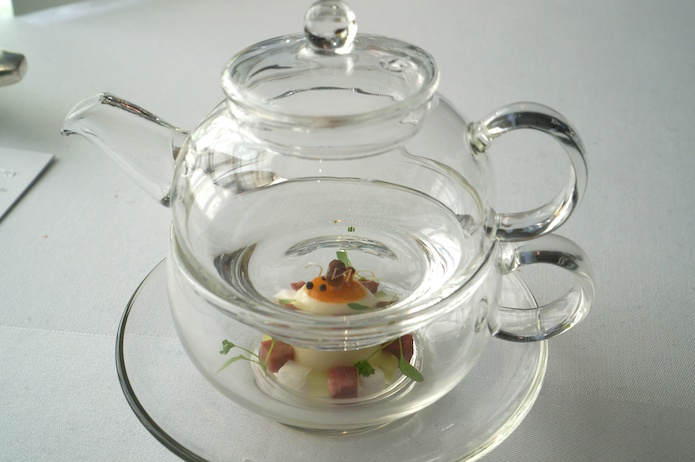
Water in the teapot – Egg, ham and mushroom
We were then each given a “pocketwatch teabag”, which was really some solid stock coated in edible gold leaf, and instructed to dunk it into the water until it dissolved.
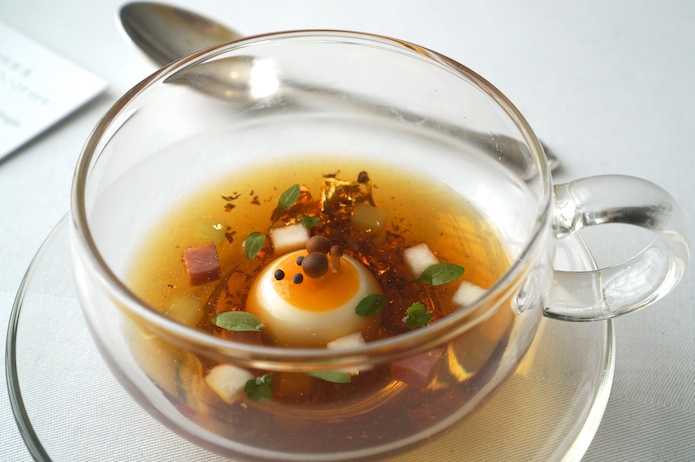
The tea after dissolving the pocket watch teabag
Served with our tea were some toast sandwiches, filled with all things delightful from cinnamon cream to truffles to lettuce to, obviously, toast. I must admit, before dining at The Fat Duck I had no idea that a “toast sandwich” was actually something that existed before Heston used the idea. It was originally published in Isabella Beeton’s Mrs Beeton’s Book of Household Management in 1861, a book published as a guide to running a Victorian household. The original recipe suggested placing a piece of cold toast in between buttered fresh bread and seasoning with pepper. Heston’s was obviously a little more fancy, but kept the idea of using toast as a textural element.
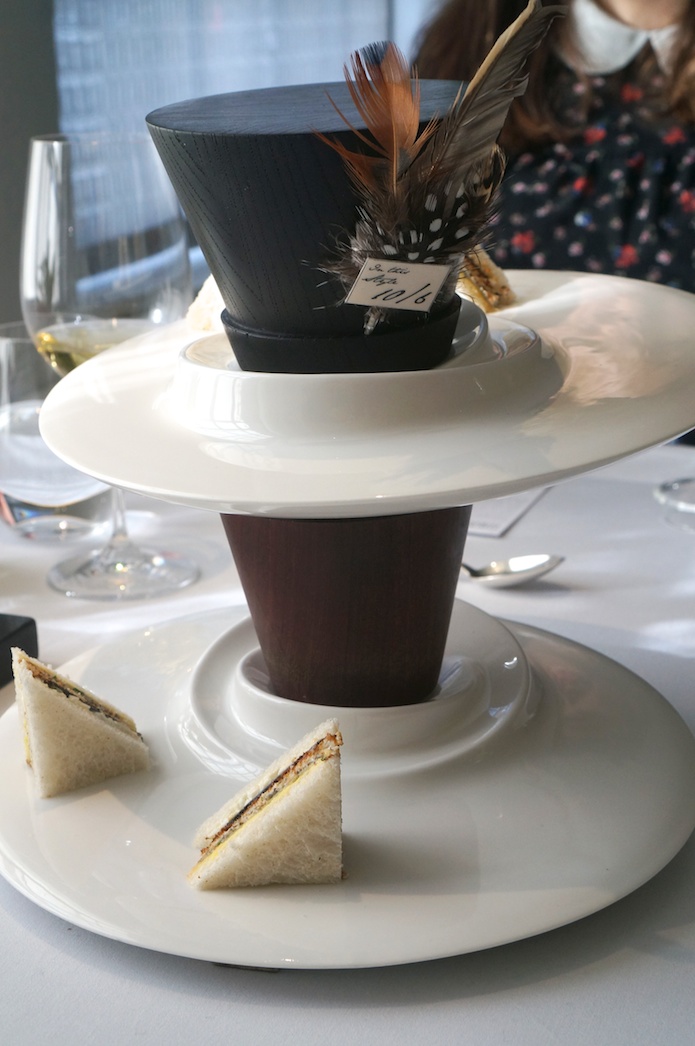
Some toast sandwiches to have with our tea
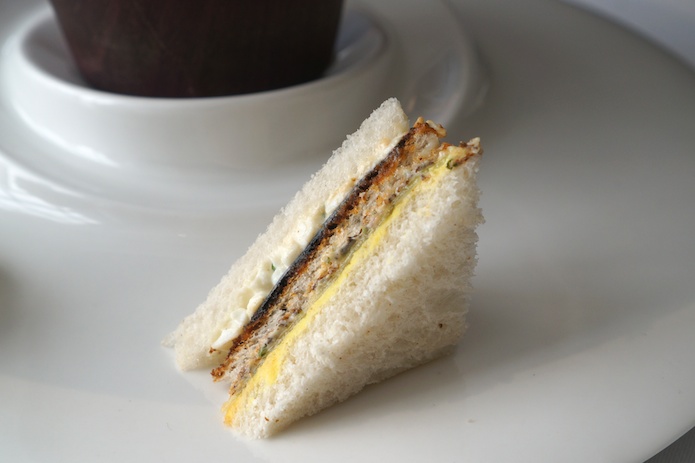
A toast sandwich – Truffle, lettuce, cinnamon cream and toast
Once again, I was left very impressed by the quality of the dish. Having had already seen a similar dish on Heston’s Feasts did make this dish all the more exciting for me, but just the flavours and textures alone were quite astounding.
Another of Heston’s famous dishes, and one which is designed to play on senses other than taste and sight, is Sounds of the Sea. Each diner was asked to listen to, quite literally, the sounds of the sea, as we ate what was made to look like the shoreline at a beach. With sand made from tapioca, a sea-water tasting foam, sashimi of abalone, kingfish and mackerel, and an assortment of different sea plants, we ate whilst listening to the sounds of crashing waves, children laughing, and seagulls singing.
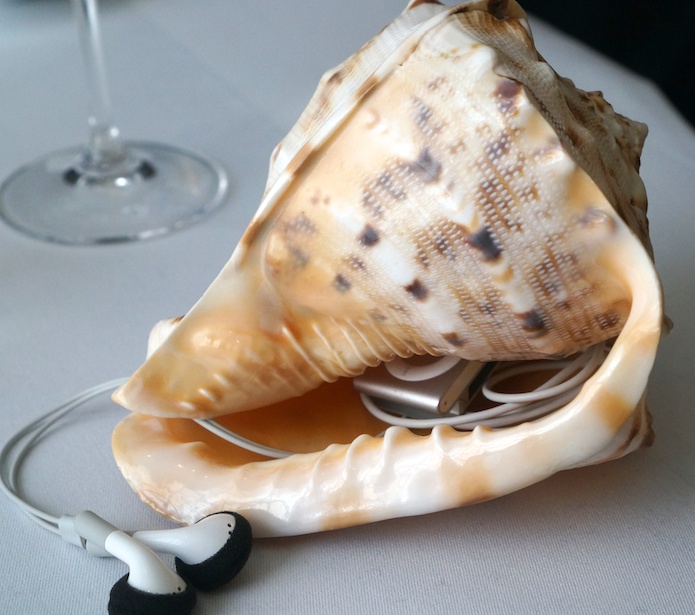
iPod in a conch playing sounds of the sea
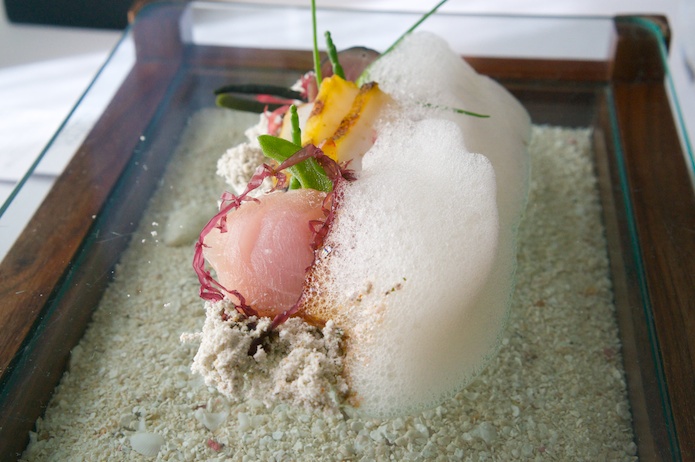
The ocean on a plate – tapioca sand, seawater foam, sashimi of kingfish, abalone and mackerel and a selection of different seaweeds.
Following were another two spectacular dishes – the first was salmon poached in a liquorice gel with vanilla mayonnaise and trout roe, and the next was a perfectly cooked piece of duck served with the smoothest potato puree I’ve ever had and a crispy cigar of umbles (really just another name for the internal organs of an animal). These two dishes were truly great, albeit much less theatrical and unusual than the previous dishes (although some of the flavour combinations in the salmon dish were very unique, but they worked).

Salmon poached in a liquorice gel with vanilla mayonnaise, trout roe, pink grapefruit and artichokes.
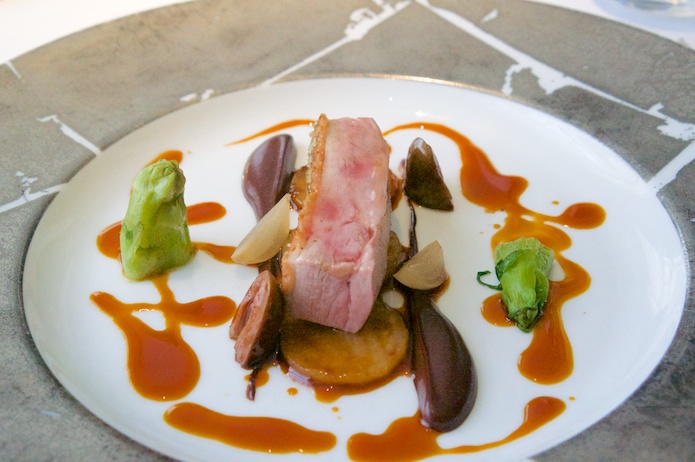
The Duck

To accompany The Duck: potato puree and a cigar of umbles
With the main meals finished, it was time for a palette cleanser. Normally restaurants would serve a tangy sorbet of some sort, but not Heston. Instead, we were brought a small cup of Hot & Iced Tea, a cup of what looked to be a uniform liquid. In fact, there were really two different viscous liquids – one hot and one cold – each infused with the flavour of Earl Grey tea. Differences in the density of each liquid meant that they would remain separated for a period of time, giving a sensation of both hot and cold in the mouth at the same time.

Hot & Iced Tea – It looks like a uniform liquid, but really it is not.
After the trippy tea came the first dessert – rhubarb with bergamot flavoured biscuit and sheep’s milk yoghurt. It was a pretty impressive dessert and certainly one of the best that I’d eaten in a restaurant. It was a little bit sweet, a little bit sour, a little bit creamy, and had an interesting mix of flavours and textures.

Rhubarb, bergamot, sheep’s milk yoghurt, sorbet and a sour sugar-candy shard
I couldn’t help but smile after eating the rhubarb dessert – I was almost in shock at how consistently impressive each course was. At the same time, though, I was doubting whether the next dessert could possibly improve on the previous – it was that good. The next dessert was also one that we were very intrigued by, given its name – Botrytis Cinerea. Having no idea what it meant, we had no idea what to expect. When it finally came to the table, it looked like a bunch of grapes on a plate. The waitress explained that Botrytis Cinerea is the name of a fungus that is often introduced to grape vines to produce sweet wines with a distinctive flavour, and that the dessert we were about to eat showcased, in a deconstructed form, each of the flavours associated with wines produced from fungus-affected grapes. It was an idea conjured up by the head sommelier of The Fat Duck.
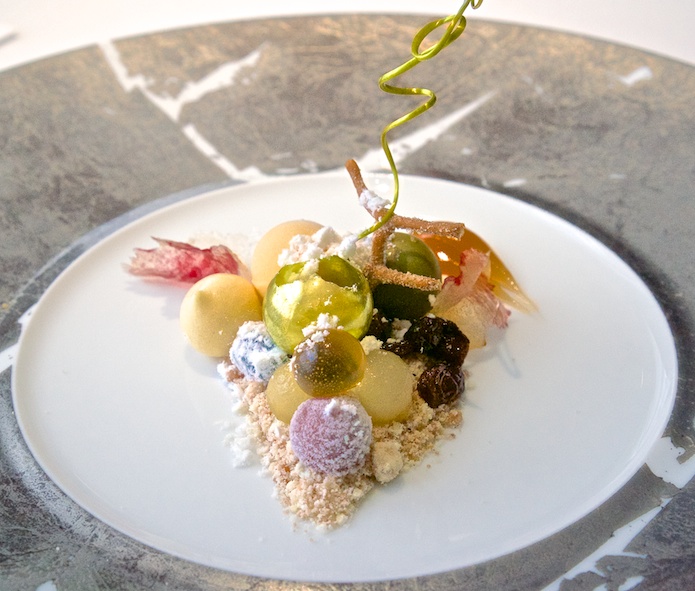
Botrytis Cinerea – Each component has a flavour characteristic of wines produced from fungus-infested grapes
As we started eating it, we couldn’t help but laugh. It was a mind-blowing dessert – we couldn’t believe how good it was. Each component had a very distinct flavour and texture, may have been filled with something, and it was always a pleasant surprise biting into the next element. I normally prefer non-dessert dishes, but I think this just may have been my favourite dish of the day.
With the main desserts finished, it was time for some whiskey al The Fat Duck. Presented in a photo frame with a map of Scotland were five whiskey wine gums, each sweet but with the flavour of different whiskeys. We were advised to start with number one and work towards number five.
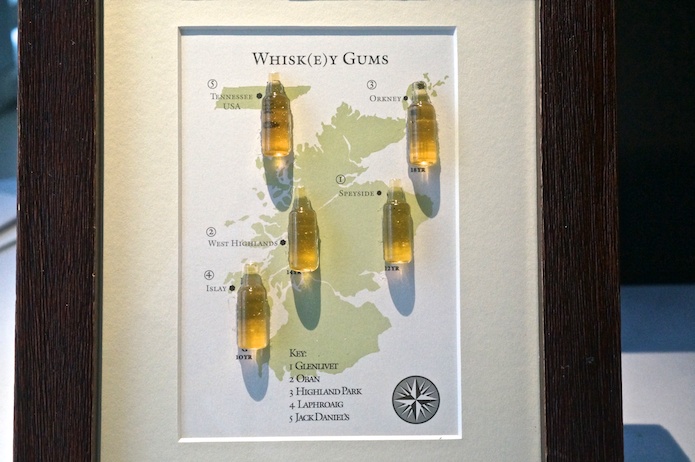
Whisk(e)y Wine Gums
Finally, the fourteenth and final course was Like a Kid in a Sweet Shop. Heston has a fascination with food memories – things that we ate as a child, foods that bring back happy memories of childhood. The Fat Duck’s version of petit fours came in a form inspired by the excitement children often feel when they walk into a shop filled with sugary sweets. The sweets were presented inside a striped paper bag and the menu describing each element was even made to smell like a sweet shop.
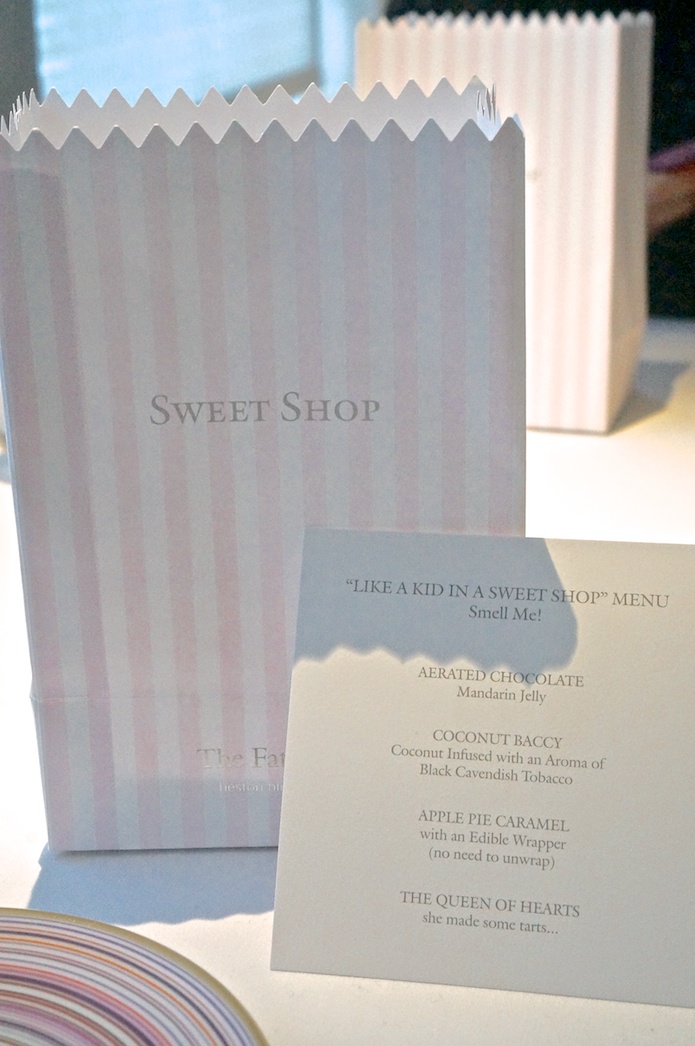
Like a Kid in a Sweet Shop
[portfolio_slideshow id=1055 include=”1122,1121,1120,1119″]
Four hours and fourteen courses later, lunch had come to an end. The restaurant called us a taxi and we made our way back to the station. The whole way back we couldn’t help but smile – not just because we had just eaten at one of the most famous and difficult to reserve restaurants owned by an incredibly well-known chef who I have come to admire, but also because it far exceeded our expectations in almost every regard. The service was outstanding, the atmosphere was incredible and the food absolutely magical. I really can’t praise it enough – we were not presented just one great dish after another, but rather one outstanding dish after another.
*Getting a Reservation
Getting a reservation can be stressful, especially if you have just have a window of a few days in which you can visit The Fat Duck. Reservations are taken only online and exactly two months in advance, and new tables are released at exactly 11am GMT+0 each morning. I’m not sure if it remains the same all year round, but all of the tables were taken in less than a minute after 11am. This means careful planning and being prepared not to get a table. Here are a few tips that I learned after three days of trying to book without success:
- Register with Toptable ahead of time. Toptable is the third party online booking system used by The Fat Duck.
- Don’t have a reservation at another restaurant through Toptable for the same day that you want to visit The Fat Duck. I had a “backup” booking at Heston’s other restaurant, Dinner, which resulted in me missing out on a seat at The Fat Duck because the system wouldn’t allow double bookings.
- If you don’t get a reservation for the dates you want, check back regularly. Cancellations are not common, but they do happen. I found that a day became available due to a cancellation, but I was not in the UK at the time.
- Make sure you have a fast internet connection.
- Have your credit card details ready, because you will need to use them when reserving a table. Rather than typing the credit card number and wasting time, type it ahead of time and then copy it to your clipboard so that you can paste it on demand when the time comes.
- Get familiar with the Toptable system ahead of time. Try booking another restaurant so that you understand how it works and which details you will need to input.
- To prevent automated programs trying to make a booking, the system requires that users enter a CAPTCHA code the first time and then again after a certain amount of time. Make sure that you do this just before 11am, so that you don’t waste time when the reservation lines open. Get familiar with the system!
- Start trying at 10:55. 11am on one clock may be 11:05 on another!
- Don’t try to get the default time that is suggested by Toptable, because there will be less chance of getting it. Try going for a late lunch during the week when there may be less people trying to get a booking.
- If you really want to get a table, plan your trip around The Fat Duck, don’t plan The Fat Duck around your trip.

Had a little laugh at your booking problems…..Its a bloody nightmare trying to get a table. I was at Dinner last week , nice meal. Thinking I might need another trip to the Fat duck now.
Lovely set of photos too , really enjoyed looking at them thanks
Take care
Alan.
Although it was very frustrating while I was trying to book, I also couldn’t help but laugh a little bit once I had finally succeeded 🙂 I went to Dinner a couple of days before The Fat Duck, and they are certainly two very different experiences!